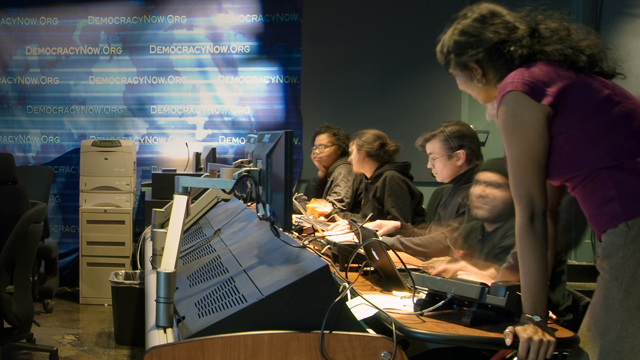
As New Yorkers head to the polls in the primaries for upcoming local elections, voters will have the chance to vote for not one, but up to five of their preferred candidates for mayor and other races. Ranked-choice voting is a relatively new system — introduced in New York following a referendum in 2019 — that has grown in popularity across the U.S. “It gives voters more choices and more power in determining the ultimate winner of an election,” says John Tarleton, editor-in-chief of The Indypendent, which is closely following the New York mayoral election.
Election day is June 24 with early voting already underway in New York.
Transcript
AMY GOODMAN: This is Democracy Now!, democracynow.org, The War and Peace Report. I’m Amy Goodman. We’re going to turn right now to ranked-choice voting. As New Yorkers head to the polls and the primaries for upcoming elections Tuesday, voters will have the chance to vote for not one but up to five of their preferred candidates for mayor and other races. Early voting actually is taking place now through Sunday. This is a brief explainer from the New York Board of Elections.
NYC BOARD OF ELECTIONS EXPLAINER: There’s a new way for New Yorkers to have their say in city elections, a way that gives voters more choices and can lead to more diverse winners. It’s called ranked-choice voting. 74% of New York voters chose to use it in primary and special elections for city offices. Mayor, public advocate, comptroller, borough president, and city council.
AMY GOODMAN: This is a relatively new system for New Yorkers. It was introduced following a referendum in 2019. It’s also in use in Maine and Alaska and is gaining interest across the country. Early voting underway now through the weekend ahead of Tuesday’s primary. I spoke to John Tarleton, editor-in-chief of The Indypendent, closely following New York City’s mayoral election and began by asking him how ranked-choice voting works and how it came to New York.
JOHN TARLETON: Sure. So, ranked-choice voting was first implemented in San Francisco in 2004, and it’s now used in about 40 cities and towns across the United States, including in Oakland; Boulder, Colorado; Minneapolis; Burlington, Vermont; Takoma Park, Maryland; and other places. And it’s also used statewide in Maine and Alaska. And like that announcement was saying, we had a voter referendum in New York that approved it in 2019, and we first implemented it 2021 in our last mayoral cycle here in New York.
AMY GOODMAN: And what’s the problem it’s correcting?
JOHN TARLETON: Well, the problem — OK, the problem it’s correcting in our kind of winner-take-all electoral system is that if you vote for a lower-performing candidate in a race where there’s a lot of candidates, your vote can be wasted or spoiled. An example I think many people could relate to in your audience is in Florida 2000, when Ralph Nader got 97,000 votes, and Al Gore ultimately lost the presidency by 537 votes. If there had been ranked-choice voting, Green Party supporters, who might have wanted to keep, you know, a Republican from getting in the White House, they could have made Al Gore their second choice.
AMY GOODMAN: They could still do Ralph Nader first.
JOHN TARLETON: Yes.
AMY GOODMAN: But they would make Al Gore second.
JOHN TARLETON: Yeah. And so, all those debates about, you know, spoilers and wasted votes that we get every four years in presidential politics, if we had ranked-choice voting, people could vote both — it allows you to both vote for who you most want, but then to also make a second-choice selection for other candidates that you also like. And it prevents the dynamic if you vote for a low-performing candidate, that someone else that you would least want to win ends up prevailing. So it gives voters more choices and more power in determining the ultimate winner of an election.
AMY GOODMAN: And so, when was it first instituted here in New York? The election is Tuesday.
JOHN TARLETON: Yeah. It was first instituted in our city elections in 2021. Under our rules here in New York, you can vote in order of preference for as many as five candidates. So, yeah, it’s really changed the dynamic of the election here.
AMY GOODMAN: John Tarleton, editor-in-chief of The Indypendent. You can see the full interview online. Early voting goes through Sunday in the New York City primary for mayor. Primary day is Tuesday.
That does it for our show. We’re hiring a Senior Headline News Producer, a Director of Audience, and a Director of Technology. You can find out more at democracynow.org/jobs. Democracy Now! is produced with Mike Burke, Renée Feltz, Deena Guzder, Messiah Rhodes, Nermeen Shaikh, Maria Taracena, Tami Woronoff, Charina Nadura, Sam Alcoff, Tey-Marie Astudillo, John Hamilton, Robbie Karran, Hany Massoud, Anjali Kamat, Safwat Nazzal. Our executive director’s Julie Crosby. Special thanks to Becca Staley, Jon Randolph, Paul Powell, Mike Di Filippo, Miguel Nogueira, Hugh Gran, Denis Moynihan, David Prude, Dennis McCormick.
I’m Amy Goodman. Thanks so much for joining us.












Media Options